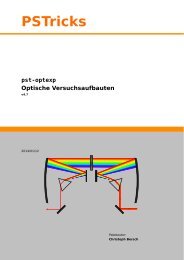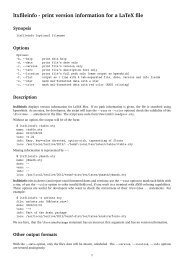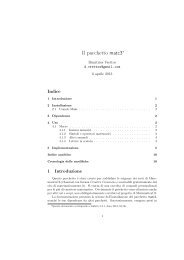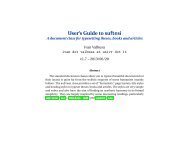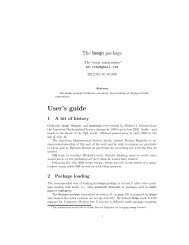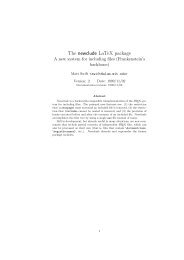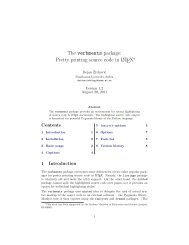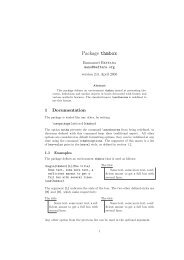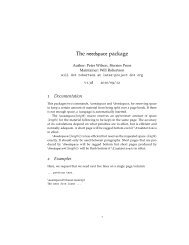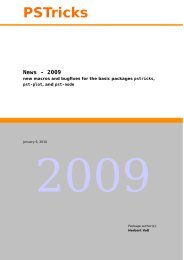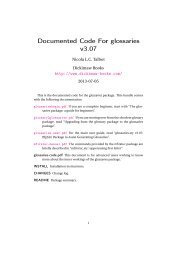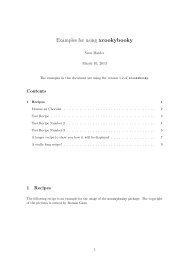The csquotes Package
The csquotes Package
The csquotes Package
You also want an ePaper? Increase the reach of your titles
YUMPU automatically turns print PDFs into web optimized ePapers that Google loves.
4.5 Controlling Active Quotes<br />
<strong>The</strong> commands introduced above merely allocate active quotes, but these characters<br />
are not immediately made active. All allocated quotes are automatically enabled<br />
at the beginning of the document body. If any active quotes are allocated in<br />
the document body, they need to be enabled with \EnableQuotes. <strong>The</strong> following<br />
commands control the state of the active quotes within a local scope.<br />
\EnableQuotes Enables all active quotes by redefining the allocated characters and making them<br />
active. It also restores them when disabled, set to verbatim, or overwritten.<br />
\DisableQuotes Disables all active quotes by restoring the original category codes and definitions<br />
of all allocated characters.<br />
\VerbatimQuotes Switches to verbatim active quotes. All active quotes will be printed verbatim until<br />
their default behavior is restored with \EnableQuotes.<br />
\DeleteQuotes Disables and deallocates all active quotes, i.e. performs a complete reset of all<br />
allocated characters so that they may be newly defined.<br />
5 Integrated Interface<br />
<strong>The</strong> commands presented in this section are extended versions of some of those<br />
discussed in § 3. <strong>The</strong>y dier from their counterparts in that they integrate automated<br />
citations into their syntax. Instead of adding \cite manually, you pass the<br />
citation arguments to the respective quotation command. See § 8.6 on how to use<br />
a command other than \cite to handle the citations.<br />
5.1 Formal Quoting of Regular Text<br />
<strong>The</strong> basic integrated command is an extended version of \textquote:<br />
\textcquote[〈prenote〉][〈postnote〉]{〈key〉}[〈punct〉]{〈text〉}〈tpunct〉<br />
\textcquote*[〈prenote〉][〈postnote〉]{〈key〉}[〈punct〉]{〈text〉}〈tpunct〉<br />
<strong>The</strong> 〈text〉 may be any arbitrary piece of text to be enclosed in quotation marks.<br />
<strong>The</strong> optional arguments 〈cite〉 and 〈punct〉 specify the citation and any terminal<br />
punctuation of 〈text〉. 〈tpunct〉 denotes trailing punctuation after the command.<br />
If the autopunct option is enabled, the quotation commands will scan ahead for<br />
punctuation marks immediately following their last argument and can move them<br />
around if required. See § 8.7 on how to change the way these arguments are handled<br />
and § 9.2 for reasons why you may want to specify the punctuation as a<br />
separate argument. <strong>The</strong> starred version of this command skips directly to the inner<br />
quotation level. <strong>The</strong> remaining arguments are handed over to \cite. Note that<br />
\cite normally supports one optional argument only. 〈prenote〉 is only available in<br />
conjunction with the natbib, jurabib, and biblatex packages. How these arguments<br />
are handled depends on the citation command. With natbib and biblatex,<br />
〈prenote〉 is in fact a notice such as ‘see’. With jurabib, this argument has a dierent<br />
function by default. <strong>The</strong> argument 〈postnote〉, which is always available, indicates<br />
the citation postnote. This is usually a page number. 〈key〉 is the citation key. See<br />
§§ 8.6 and 8.7 on how to customize the citation.<br />
10



